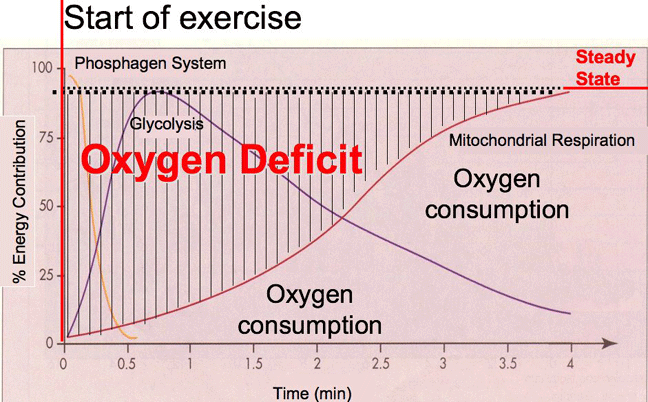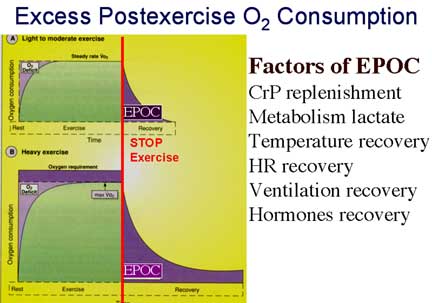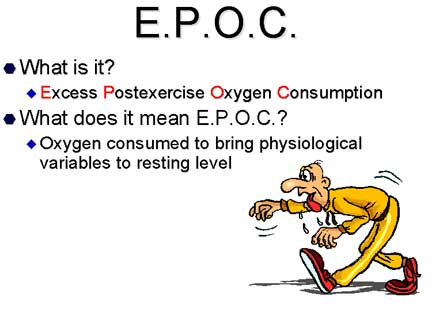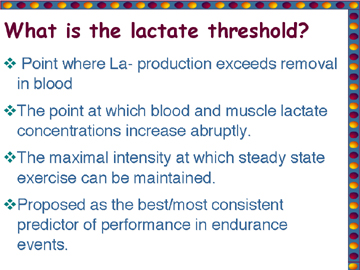|
|
| Oxygen Deficit, EPOC, Lactate Formation, Lactate Threshold Training Draw and Explain the Oxygen Deficit. During the first few minutes of cardiovascular exercise, the anaerobic energy systems (CrP-ATP and glycolysis) supply the needed ATP for this work. The energy provided during this deficit phase of exercise is employed until a steady-state (or steady-rate) of oxygen consumption is utilized, thus indicating that mitochondrial respiration is the dominant energy system being utilized. However, it should be noted that energy for exercise is not merely the result of a series of energy systems “switching on” and “switching off,” but rather the smooth blending and overlap of the body's three energy systems. SHORT DEFINITION OF OXYGEN DEFICIT: Deficit (O2) at start of exercise met by the phosphagen and glycolytic energy systems.
Draw and Explain the EPOC. EPOC stands for the Excess Postexercise Oxygen Consumption. This is the recovery period after cardiovascular exercise where there is elevated oxygen consumption. It can be described as the amount of oxygen consumed during recovery in excess of that which would have ordinarily been consumed at rest. Some factors that contribute to EPOC include the replenishment of CrP and ATP, the metabollism (i.e., conversion) of lactate to pyruvate, and hormone recovery. In addition, during this recovery period the increased oxygen demand is needed to help the body in recoveying the increased body temperature, heart rate and ventilation to a pre-exercise level.
Explain the Lactate Formation. This is just a REVIEW in the following section. We have already covered Lactate Formation in PEP326L At the end of glycolysis there are two pyruvate and two NADH+H+ molecules. During resting and steady state conditions, the NADH+H+ shuttle their hydrogens to FAD (reducing FAD to FADH2) in the inner membrane of the mitochondria and pyruvate is transported to the mitochondrion matrix (for further oxidation). However, in strenuous exercise, the energy demands exceed the oxygen supply in the ETC (and a back-up occurs in the ETC). The NADH + H+ moleculres are inhibited and thus donate their hydrogens to pyruvate, reducing pyruvate to lactate. NAD+ can now return to Step 6 of glycolysis to pick up more hydrogens and glycolysis can continue. Rebecca Fattley, 2004. Class, the following is EXTRA information that is not tested. It is just for your 'Breadth, Depth and Understanding' and how we still use the build-up of lactate (measured in the lab) for training purposes. Describe and Explain the Lactate Threshold (Reviewing what we already know to go to the next step) At rest your blood lactate is about 1.0 mM/L. As exercise intensity increases there is a point where your body begins to produce more lactate then it can eliminate. Scientists have identified this point to be where blood lactate is from 2.0 to 4.0 mM/L. During this demanding exercise, mitochondrial respiration is unable to keep up with the pace of the oxygen demand. Thus, the body accommodates by increasing glycolysis. However, glycolysis becomes limited by the fact that it cannot shuttle the NADH + H+ (from Step 6 of glycolysis) through the mitochondrial membrane. Therefore, pyruvate reacts (in the cytoplasm) with NADH + H+ to form lactate, which begins to accumulate in the blood. The intensity at the lactate threshold represents the maximal intensity at which steady-state exercise can be maintained.
Training the Lactate Threshold (Summary thoughts from Steve Burns, PHD.) Training the lactate threshold is similar to training for strength. The body adapts to stress overload placed upon it by becoming more efficient. To stress the body to cause an increase in efficiency, the athlete needs to increase the lactate above that which he/she can tolerate. This is done in training by exercising at a high intensity for several short periods and recovering between hard bouts, allowing excess lactate to clear the muscle. The higher the intensity, the greater the lactate build-up. The less the rest between hard bouts, the higher the lactate build-up. A proper mix of hard efforts with short recovery, and some medium hard efforts with longer recovery, will raise both the lactate threshold and the VO2max. Also, endurance exercise is included to increase overall musculoskeletal health. Remember, while training the aerobic energy system the athlete will also be training the phosphagen and glycolytic system. For a Complete article on Lactate Theshold Training, CLICK HERE! |
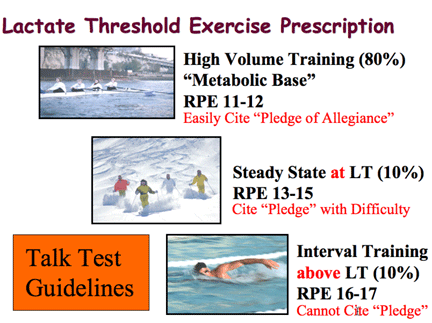 |
| Top of Page | | Research Interests | | Vita | | Articles | | New Projects | | Miscellaneous | | UNM | | Home |
